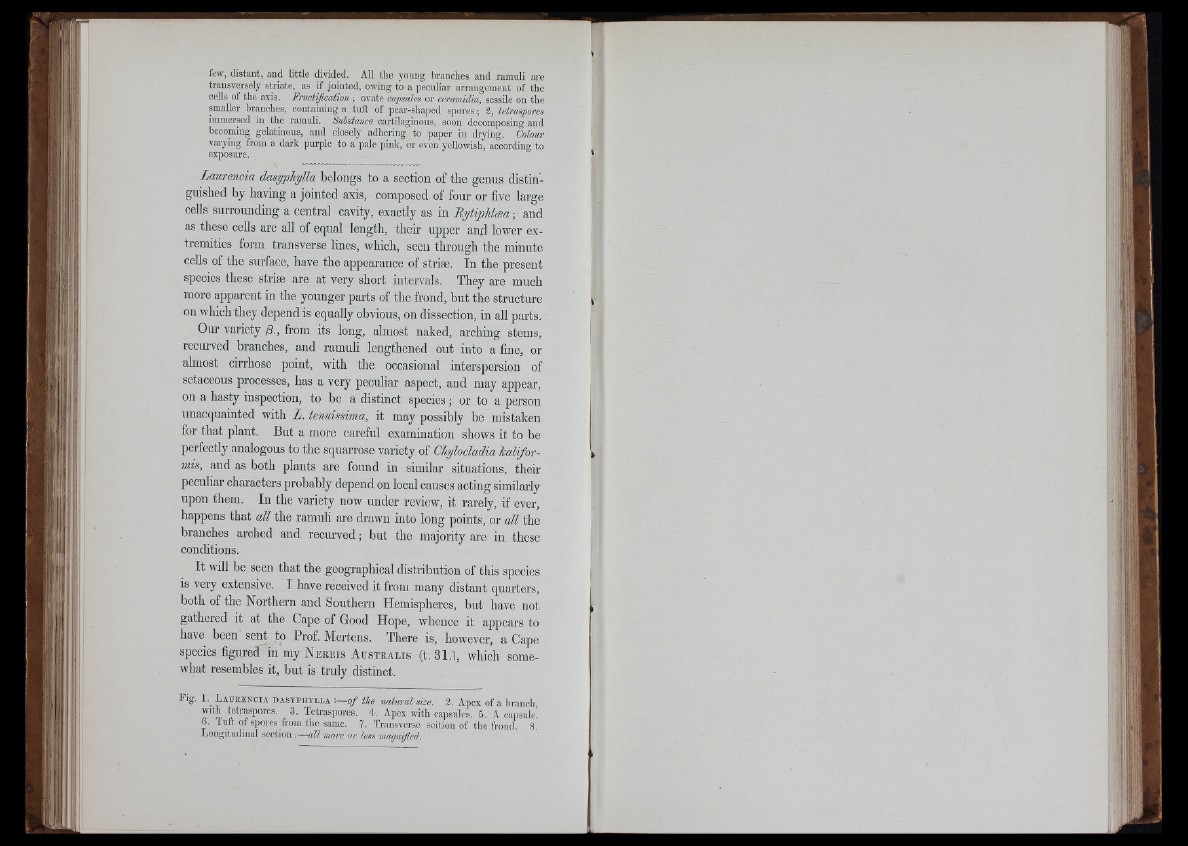
few, distant, and little divided. All the young branches and ramuli are
transversely striate, as if jointed, owing to a peculiar arrangement of the
cells of the axis. Fructification ; ovate capsules or ceramidia, sessile on the
smaller branches, containing a tuft of pear-shaped spores ; 3, tetraspores
immersed in the ramuli. Substance cartilaginous, soon decomposing and
becoming gelatinous, and closely adhering to paper in drying. Colour
varying from a dark pui-ple to a pale pink, or even yellowish, accordmg to
exposure.
Laurencia dasyphylla belongs to a section of the genus distinguished
by having a jointed axis, composed of four or five large
cells surrounding a central cavity, exactly as in Mytiphlæa -, and
as these cells are all of equal length, their upper and lower extremities
form transverse lines, which, seen through the minute
cells of the surface, have the appearance of striæ. In the present
species these striæ are at very short intervals. They are much
more apparent in the younger parts of the frond, but the structure
on which they depend is equally obvious, on dissection, in all parts.
Our variety /3., from its long, almost naked, arching stems,
recurved branches, and ramuli lengthened out into a fine, or
almost cirrhose point, with the occasional interspersion of
setaceous processes, has a very peculiar aspect, and may appear,
on a hasty inspection, to be a distinct species ; or to a person
unacquainted with L. tenuissima, it may possibly be mistaken
for that plant. But a more careful examination shows it to be
perfectly analogous to the squarrose variety of Chylocladia halifor-
mis, and as both plants are found in similar situations, their
peculiar characters probably depend on local causes acting similarly
upon them. In the variety now under review, it rarely, if ever,
happens that all the ramuli are drawn into long points, or all the
branches arched and recurved ; but the majority are in these
conditions.
It will be seen that the geographical distribution of this species
is very extensive. I have received it from many distant quarters,
both of the Northern and Southern Hemispheres, but have not
gathered it at the Cape of Good Hope, whence it appears to
have been sent to Prof. Mertens. There is, however, a Cape
species figured in my N ereis Australis ft. 31.), which somewhat
resembles it, but is truly distinct.
K g . 1. L aurencia dasyphylla :— q f tlie natural size. 2. Apex of a branch
with tetraspores. 3. Tetraspores. 4. Apex with capsules. 5, A capsule!
6, lu lt of spores from the same, 7. Transverse scitiou of the frond. 8.
Longitudinal section:—all more or less magnified.
'r''
■Í,
11
IÍ1
. Í ' '